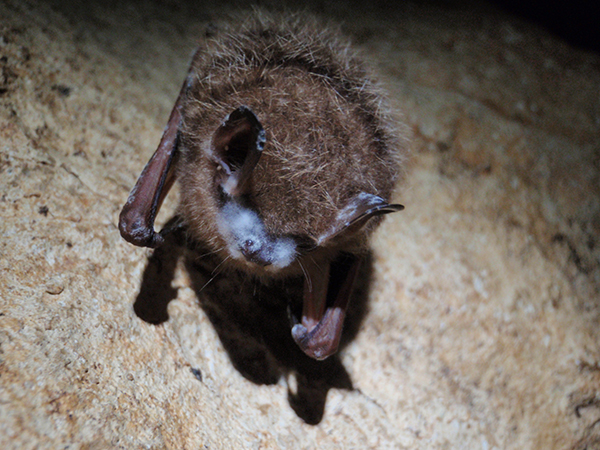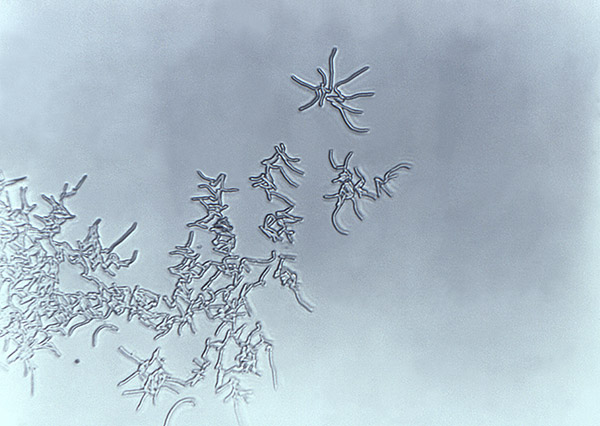
by Mary Caperton Morton Tuesday, June 16, 2015

A tri-colored bat in a cave in Cumberland Gap National Historic Park afflicted with White Nose Syndrome. Credit: National Park Service
Since White Nose Syndrome began decimating bat colonies in New England in 2006, most of the news coming out of bat caves in the U.S. hasn’t been good. To date, as many as 6 million bats in 26 states have died as a result of infection. But a new trial pitting a particular soil bacterium against White Nose is providing a glimmer of hope in the fight to slow its devastating march across the country.
White Nose Syndrome is caused by a fungus called Pseudogymnoascus destructans, which thrives in the cold, damp conditions often found in caves and crevices where bats hibernate during winter. As the fungus grows on bats’ faces, wings and bodies, it inhibits the creatures’ ability to mitigate dehydration and maintain body temperature during hibernation. In infected hibernacula, mortality rates typically range between about 80 and 100 percent.
In the past few years, a number of groups have been searching for biological or chemical agents that might combat the fungus without further harming bats or damaging the often delicate ecology of caves. A potential breakthrough recently put to the test began, oddly enough, with bananas.
“Originally, we were looking for bacteria that would help delay the ripening of fruits and vegetables,” says Chris Cornelison, a microbiologist at Georgia State University and lead researcher of a study that will be submitted to BMC Biology detailing the new technique to counter White Nose Syndrome. In experimental trials, Cornelison and colleagues noticed that bananas exposed to the bacterium Rhodococcus rhodochrous, which occurs naturally in soils, had a lower fungal burden than untreated bananas.
“I had seen news reports about White Nose Syndrome, and the idea came to me that if _Rhodococcus _could prevent mold from growing on bananas, maybe it could also prevent mold from growing on bats,” he says.

Rhodococcus bacteria, one species of which has been found to inhibit the growth of Pseudogymnoascus destructans fungi that causes White Nose Syndrome. Credit: Centers for Disease Control and Prevention
After testing to ensure that the _Rhodococcus _bacterium wasn’t harmful to bats, Cornelison, along with Sybill Amelon and Daniel Lindner, both with the U.S. Forest Service, captured roughly 150 infected bats from cave sites in Missouri and Kentucky last fall as the animals returned to their hibernacula. In the treatment, the bats — after entering hibernation on their own — were hung in small mesh bags inside picnic-sized coolers containing bacteria-filled petri dishes for 48 hours.
“One of the best features of this bacterium is that the bats don’t need to come into direct contact with it to be treated,” Cornelison says. That’s because _Rhodococcus _produces a vapor of organic compounds, which disperse into the air and appear to inhibit growth of P. destructans.
After treatment, the hibernating experimental bats were returned to their caves, held inside protective mesh bags so that they could be monitored throughout the winter. Then, in April, the animals were brought back to the lab and assessed for body mass index, fungal burden and damage to the wings. Most of the infected bats had still sustained damage to their wings, Cornelison says. But “some that survived were heavily infected before treatment and probably would have died without treatment.”
Many of the bats needed time to recover from the wing damage, but on May 19, about half of the animals treated for White Nose — mostly little brown bats, plus a few northern long-eared bats — were successfully released at the Mark Twain Cave Complex in Hannibal, Missouri.
“It’s jumping the gun to call this is a cure, but it’s very promising,” says Katie Gillies, director of the Imperiled Species Program at Bat Conservation International, who was not directly involved in the new research (although Bat Conservation International provided funding to support the work). “This work shows that our efforts to combat White Nose are not in vain. The bat world has been bleak for a few years, so we’re very grateful and excited to get some positive news.”
Cornelison says he and his colleagues plan to publish the results of their lab trials in a peer-reviewed journal within the next month, and that they are still working to analyze results of field trials completed in April. “We’re aware there is a lot of interest in these data, and we’re very engaged in trying to get the data out as soon as possible.”
Because of the hands-off procedure of the _Rhodococcus _treatment, the technique could prove to be a far more logistically feasible way to treat wild bats than applying a topical treatment, Cornelison says. “Applying medicine directly to a whole colony of hibernating bats would be terribly inefficient, at best.”
But, he notes, more work will need to be done before the new treatment can be applied to bat colonies across the country. “Before we encourage resource managers to start spraying this bacterium into caves, we need to fully characterize the potential for nontarget effects to bats and cave environments,” he says.
Cornelison says he hopes that other research groups will come up with additional tactics against White Nose Syndrome. “It’s unlikely that _Rhodococcus _will stop White Nose Syndrome by itself,” he says. “We’re going to need an integrated disease-management strategy with a number of control tools that can be applied together if we’re going to get the upper hand on this disease.”
© 2008-2021. All rights reserved. Any copying, redistribution or retransmission of any of the contents of this service without the expressed written permission of the American Geosciences Institute is expressly prohibited. Click here for all copyright requests.